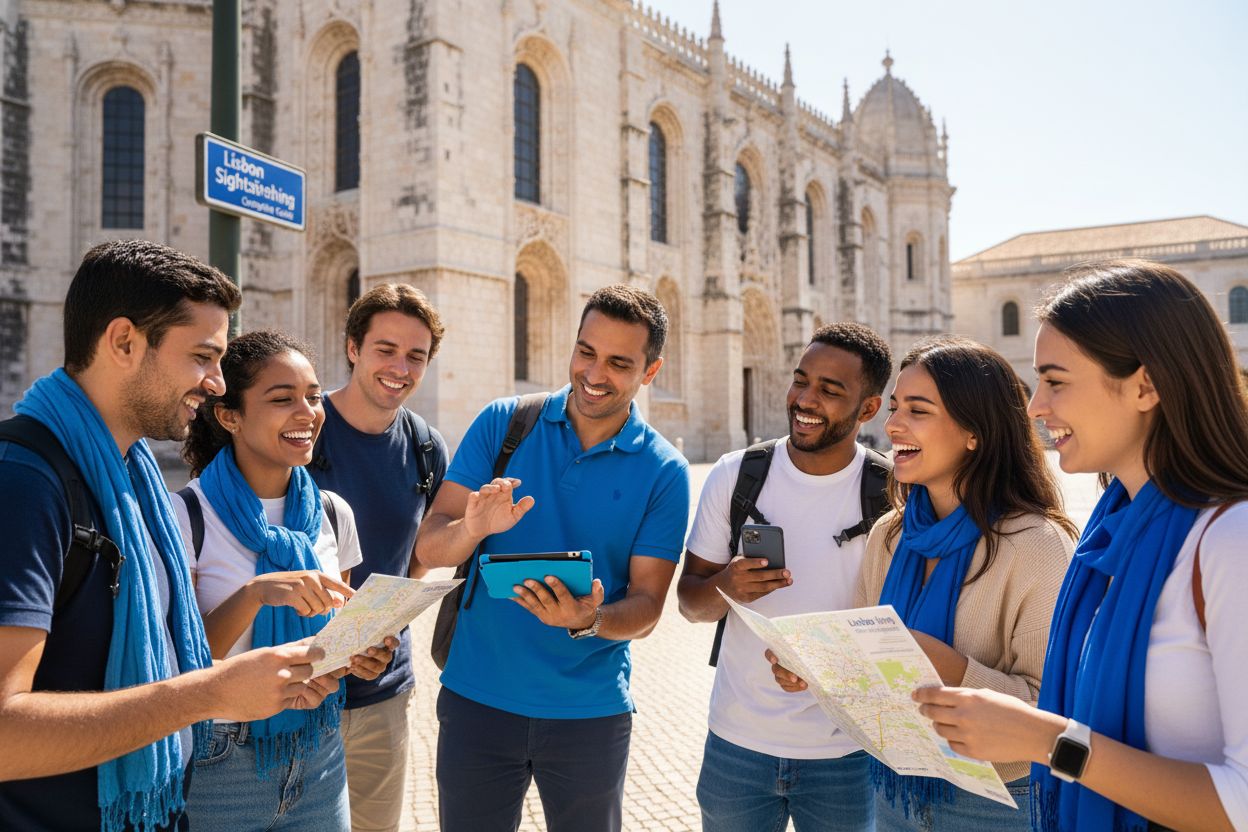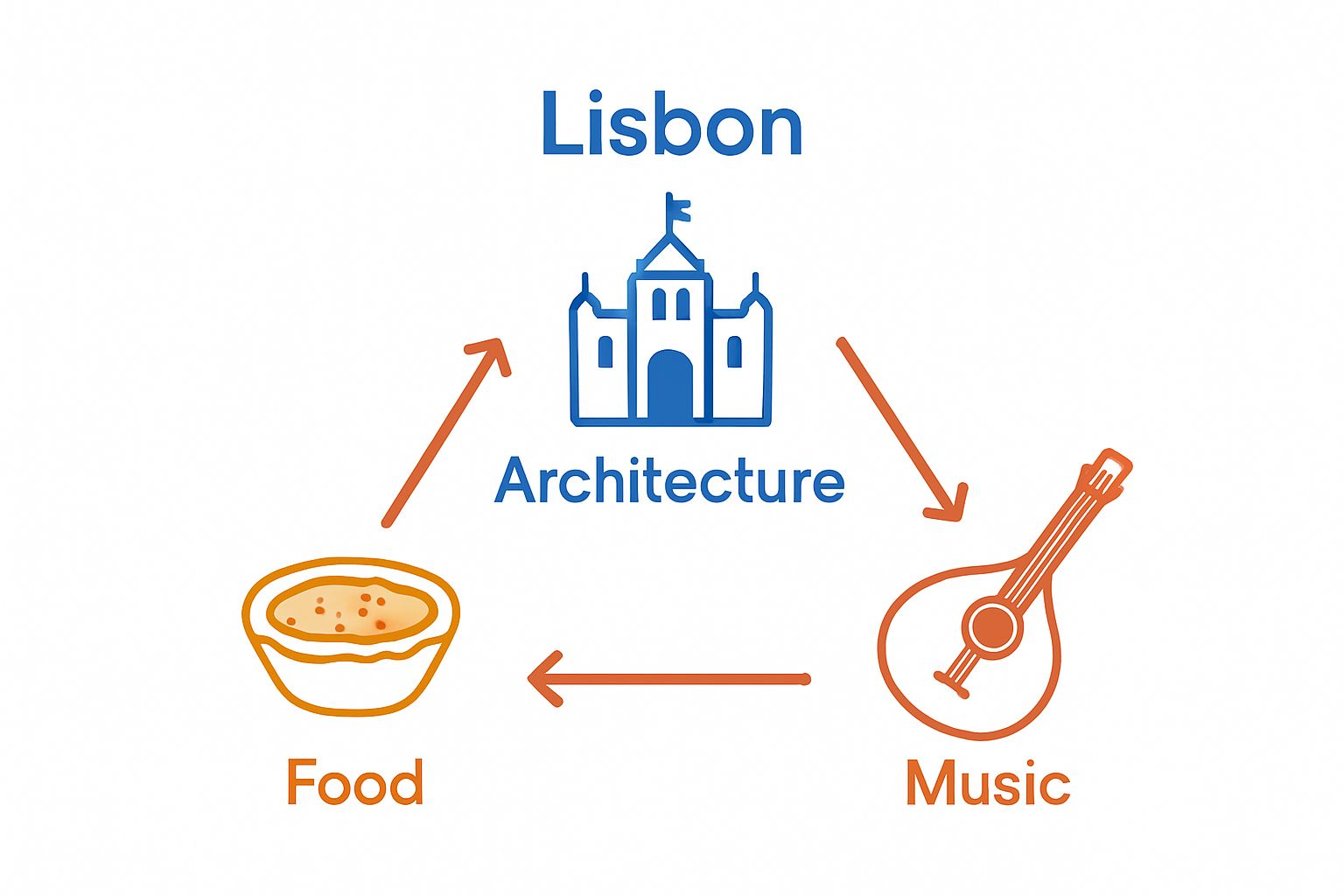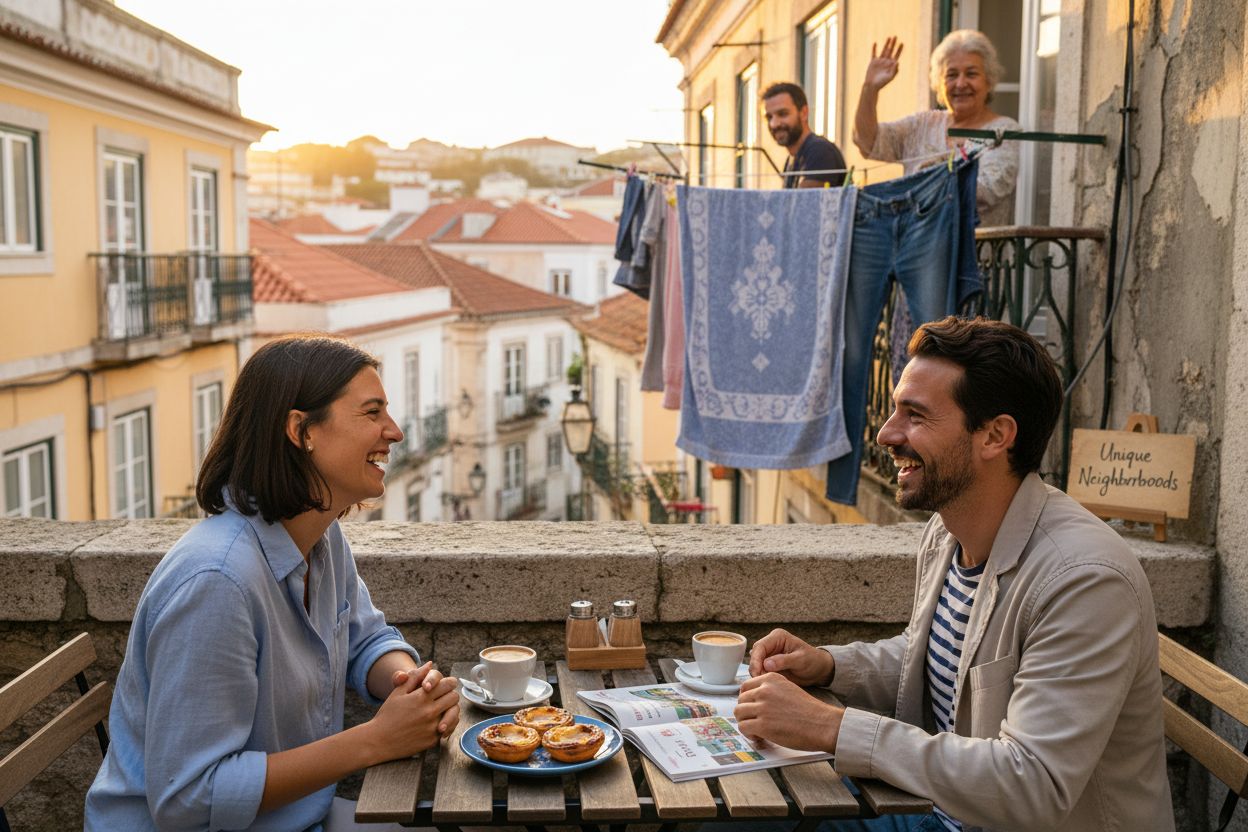Understanding Lisbon Sightseeing: Your Complete Guide
- lisbonbyboat
- Oct 12
- 9 min read

Lisbon sparkles with history around every corner and draws millions each year with its iconic yellow trams and stunning tiled facades. But here is something surprising. The historic Belém area is actually a UNESCO World Heritage Site, and Lisbon’s center has been globally recognized for its monumental significance. Sightseeing here is not about checking off famous spots. The real discovery comes from diving into the city’s layers of cultural tradition, maritime legacy, and living neighborhoods that transform every walk into an immersive story.
Table of Contents
Quick Summary
Takeaway | Explanation |
Explore Lisbon’s Historical Sites | Visit neighborhoods like Alfama and Belém to experience rich architectural history and cultural evolution firsthand. |
Engage with Local Culture | Immerse yourself in local traditions, music, and cuisine for a deeper understanding of Lisbon’s identity. |
Participate in Local Events | Take part in public celebrations, street festivals, and music performances for authentic cultural interactions. |
Prioritize Sustainable Tourism | Opt for pedestrian zones and eco-friendly experiences to enhance your sightseeing while supporting the environment. |
Discover Unique Neighborhoods | Each district offers a distinct blend of history and culture, enriching your exploration of Lisbon. |
What is Lisbon Sightseeing and Its Significance?
Lisbon sightseeing represents a profound exploration of one of Europe’s most historically rich and visually stunning cities, offering travelers an immersive journey through centuries of cultural heritage and maritime legacy. This comprehensive experience goes far beyond merely visiting tourist spots, transforming into a deep understanding of Portugal’s vibrant capital and its remarkable historical narrative.
Unveiling the Urban Tapestry of Lisbon
At its core, Lisbon sightseeing provides visitors with an opportunity to witness the city’s extraordinary architectural and cultural evolution. The experience encompasses exploring iconic landmarks, understanding historical narratives, and discovering the intricate connections between maritime exploration, architectural marvels, and contemporary urban life. UNESCO recognized Lisbon’s historical significance by designating its city center, particularly the Belém area, as a World Heritage Site, underscoring the global importance of its historical monuments.
The Multifaceted Nature of Urban Discovery
Lisbon sightseeing is not a monolithic experience but a dynamic, multilayered journey that encompasses various dimensions. Travelers can engage with the city through multiple lenses:
Historical Exploration: Walking through ancient neighborhoods like Alfama and Belem, witnessing architectural testimonies of different epochs
Cultural Immersion: Experiencing local traditions, music, cuisine, and contemporary urban lifestyle
Maritime Heritage: Understanding Portugal’s profound maritime history and its global exploration legacy
Sustainable Urban Experience
Modern Lisbon sightseeing also reflects contemporary urban values. The city has implemented innovative urban strategies that prioritize pedestrian zones and reduce car traffic, enhancing the tourist experience while promoting sustainable urban mobility. This approach transforms sightseeing from a passive activity into an interactive, environmentally conscious exploration.
For travelers seeking a comprehensive understanding of this remarkable city, our guide on understanding Lisbon’s city history offers deeper insights into the urban narrative that shapes this extraordinary destination.
Why Explore Lisbon’s Cultural Heritage?
Lisbon’s cultural heritage represents a profound narrative of human resilience, artistic innovation, and historical transformation that extends far beyond traditional tourism. Understanding this heritage provides travelers with an immersive experience that connects them to the deep emotional and intellectual landscape of Portugal’s capital city.

The Living Tapestry of Historical Narratives
Cultural heritage in Lisbon is not a static museum exhibit but a dynamic, breathing ecosystem of stories, traditions, and living memories. Each neighborhood, monument, and street corner tells a unique story of survival, creativity, and cultural resilience. UNESCO recognized Fado as an Intangible Cultural Heritage, highlighting how music itself becomes a profound medium of cultural expression and historical documentation.
Dimensions of Cultural Exploration
Exploring Lisbon’s cultural heritage offers multiple layers of understanding and engagement:
Architectural Storytelling: Witnessing architectural styles from Moorish influences to Manueline designs that narrate Portugal’s complex historical journey
Musical Traditions: Experiencing Fado music as an emotional landscape that captures the Portuguese concept of “saudade” or profound melancholic longing
Culinary Heritage: Understanding how traditional recipes and cooking techniques represent generations of cultural exchange and adaptation
Beyond Tourist Experiences
Cultural heritage exploration in Lisbon transcends typical sightseeing by offering profound connections with local communities and authentic experiences. By engaging with living traditions, travelers gain insights into the city’s soul, understanding how historical narratives continue to shape contemporary Portuguese identity.
The following table provides a comparison of the core dimensions of cultural heritage exploration in Lisbon, helping readers understand the various ways to engage with the city’s rich traditions.
Dimension | Description | Examples or Highlights |
Architectural Storytelling | Architectural styles reflect historical periods and influences | Moorish elements, Manueline design |
Musical Traditions | Music as emotional and historical documentation | Fado performances, “saudade” concept |
Culinary Heritage | Food as a record of cultural exchange and adaptation | Traditional recipes, local markets |
Community Engagement | Connecting with local communities and living traditions | Street festivals, neighborhood events |
For budget-conscious travelers interested in exploring Lisbon’s cultural richness, understanding cultural heritage provides meaningful experiences without extensive financial investment, transforming travel from mere observation to genuine cultural immersion.
How Diverse Attractions Shape the Sightseeing Experience?
Lisbon’s sightseeing landscape represents a complex, multifaceted journey that transforms traditional tourist experiences into a rich tapestry of historical, cultural, and contemporary exploration. The city’s attractions are not merely isolated landmarks but interconnected narratives that collectively reveal Portugal’s profound urban complexity.
Architectural Diversity as a Storytelling Medium
Architecture in Lisbon serves as a powerful storytelling mechanism, where each building and monument communicates layers of historical transformation. From medieval Moorish quarters to elegant Pombaline structures and contemporary architectural marvels, the city presents a visual chronology of human achievement. UNESCO’s World Heritage recognition highlights how these architectural elements are not just physical structures but living testimonials of cultural evolution.
Multidimensional Cultural Experiences
Lisbon’s attractions offer visitors a multidimensional exploration that goes beyond traditional sightseeing. These experiences can be categorized into interconnected dimensions:
Historical Exploration: Ancient castles, monasteries, and archaeological sites that document centuries of Portuguese civilization
Artistic Discovery: Museums, street art, and cultural centers showcasing both classical and contemporary artistic expressions
Urban Landscape: Neighborhoods like Alfama and Belem that represent living museums of architectural and social transformation
Sensory and Immersive Engagement
The diversity of Lisbon’s attractions creates an immersive experience that engages multiple senses. Visitors do not simply observe but actively participate in the city’s narrative. Sounds of traditional Fado music, aromas of local cuisine, textural experiences of historic cobblestone streets, and visual panoramas of architectural wonders combine to create a holistic sensory journey.
For art enthusiasts looking to dive deeper into Lisbon’s cultural offerings, understanding this multifaceted approach transforms sightseeing from a passive activity into an active, enriching exploration of human creativity and historical continuity.
What Makes Lisbon’s Neighborhoods Unique for Tourists?
Lisbon’s neighborhoods represent intricate microcosms of cultural diversity, each presenting a distinctive narrative that transforms urban exploration into an intimate journey of discovery. These unique districts offer travelers far more than geographical locations, providing profound insights into the city’s complex social and historical fabric.
Historical Layering and Architectural Identity
Each neighborhood in Lisbon tells a distinctive story through its architectural composition and urban design. From the narrow, winding streets of Alfama with its Moorish influences to the elegant, grid-like structures of Baixa, these areas represent living museums of architectural evolution. The preservation of distinct architectural styles demonstrates how urban spaces become repositories of cultural memory, allowing visitors to physically traverse through different historical epochs.
Neighborhood Characteristics and Cultural Experiences
Lisbon’s neighborhoods offer travelers multifaceted experiences that go beyond traditional sightseeing:
Alfama: The oldest district, characterized by labyrinthine streets, traditional Fado houses, and stunning panoramic views
Bairro Alto: A vibrant quarter known for its bohemian atmosphere, nightlife, and artistic community
Belém: A historic area representing Portugal’s maritime heritage, home to significant monuments and cultural institutions
Sensory and Social Dimensions
What truly distinguishes Lisbon’s neighborhoods is their ability to engage visitors through sensory and social experiences. Each district presents a unique atmosphere defined by local sounds, aromas, culinary traditions, and social interactions. The neighborhoods are not static environments but dynamic spaces where historical narratives continuously unfold.
Below is a table summarizing the unique characteristics and experiences offered by Lisbon’s key neighborhoods, providing a quick reference for travelers planning their exploration.
Neighborhood | Main Characteristics | Notable Experiences |
Alfama | Oldest district, labyrinthine streets, Moorish influences | Fado houses, panoramic viewpoints |
Bairro Alto | Bohemian vibe, vibrant nightlife, artistic community | Nightlife, artistic performances, local bars |
Belém | Historic area, maritime heritage, monumental architecture | Major monuments, museums, pastries |
Baixa | Grid-like layout, Pombaline architecture, shopping area | Elegant squares, shopping, historical cafes |
Mouraria | Diverse cultures, birthplace of Fado music | Cultural festivals, music, authentic dining |

For travelers interested in exploring Lisbon’s vibrant social scenes, understanding these neighborhood dynamics provides a deeper, more authentic travel experience that transcends conventional tourism.
Understanding the Importance of Local Events in Sightseeing
Local events in Lisbon transform traditional sightseeing from passive observation into an immersive, dynamic cultural experience. These events are not merely entertainment but profound cultural expressions that provide visitors with deep insights into the city’s social fabric, traditions, and collective identity.
Cultural Narratives Through Public Celebrations
Local events serve as living archives of cultural memory, where historical traditions are not just remembered but actively performed and celebrated. From street festivals to traditional music performances, these gatherings reveal the intricate social dynamics and emotional landscapes of Portuguese urban life. The Festas de Lisboa exemplifies how public celebrations animate urban spaces, transforming neighborhoods into vibrant stages of cultural storytelling.
Dimensions of Local Event Experiences
Lisbon’s local events offer multifaceted engagement for visitors, presenting unique opportunities for cultural immersion:
Musical Festivals: Showcasing traditional Fado performances and contemporary music genres
Historical Commemorations: Public events that celebrate significant moments in Portuguese history
Seasonal Celebrations: Festivals marking agricultural, religious, and community traditions
Interactive Cultural Discovery
Participating in local events allows tourists to transcend the role of passive observers, becoming active participants in the city’s living culture. These experiences provide unscripted, authentic interactions with local communities, offering deeper understanding beyond traditional tourist routes. For travelers seeking comprehensive exploration strategies, integrating local events into sightseeing creates a more nuanced, personal connection with Lisbon’s urban landscape.
Elevate Your Lisbon Sightseeing: Discover the City from the Water
After discovering how Lisbon’s history, neighborhoods, and culture weave together on land, you might still feel there’s a missing piece. Traditional sightseeing can leave you longing for a more immersive way to truly connect with Lisbon’s maritime roots and stunning landscape. If you want a new perspective or feel overwhelmed by crowded city routes, experiencing the city from the water is the answer. Our daily sailing tours bring Lisbon’s architectural gems and local heritage to life, letting you explore the city just as ancient explorers did.

Step aboard for an unforgettable journey. See monuments and UNESCO sites from the Tagus River and hear fascinating stories from our expert guides. Choose a private sailing cruise for deeper cultural immersion or join a daily group tour to enjoy a breathtaking blend of history and scenery. Spots are limited, so plan your best Lisbon adventure today at Lisbon by Boat and let the city reveal itself in ways you never imagined.
Frequently Asked Questions
What are the must-see historical landmarks while sightseeing in Lisbon?
To fully appreciate Lisbon’s rich history, visit the iconic landmarks such as Jerónimos Monastery, Belém Tower, and the São Jorge Castle. Create an itinerary that includes at least three to five key sites to ensure you capture the essence of the city’s past.
How can I immerse myself in Lisbon’s cultural heritage during my visit?
Engage with the local culture by attending Fado performances and exploring traditional markets. Plan to participate in at least one cultural event or festival to connect quickly with the spirit of the city.
What are the best neighborhoods to explore for a unique sightseeing experience in Lisbon?
Consider visiting the Alfama, Bairro Alto, and Belém neighborhoods, each offering distinct architectural styles and cultural atmospheres. Spend a few hours in each to appreciate how they contribute to Lisbon’s overall diversity and charm.
How can I incorporate local events into my sightseeing plans in Lisbon?
Research upcoming local events like street festivals or musical performances and schedule them into your sightseeing itinerary. Aim to include at least one event during your stay to enhance your understanding of local traditions.
What steps can I take to ensure sustainable sightseeing in Lisbon?
Prioritize pedestrian-friendly areas and consider using public transportation when possible to reduce your carbon footprint. Aim to explore at least two neighborhoods on foot each day to fully embrace a sustainable travel approach.
How can I learn about Lisbon’s maritime history while sightseeing?
Visit the Maritime Museum and the Discoveries Monument to gain insights into Portugal’s naval exploration history. Allocate a couple of hours to delve into these sites for a thorough understanding of maritime heritage.
Recommended


Comments